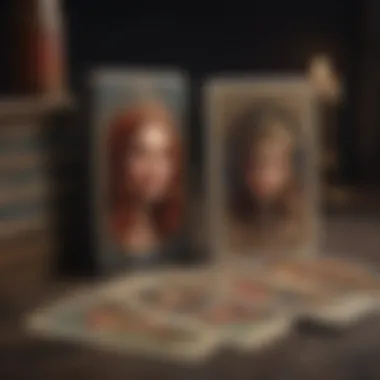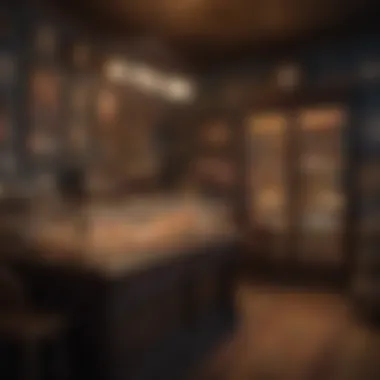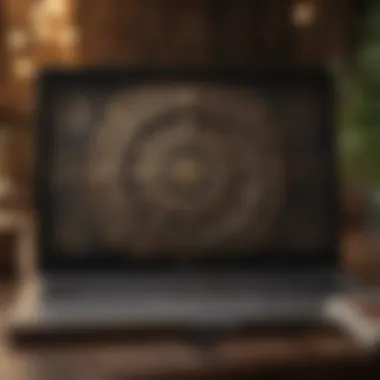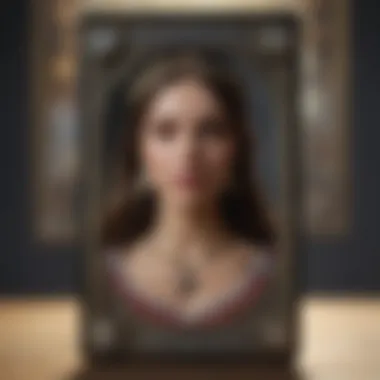Where to Purchase Tarot Cards: A Comprehensive Guide


Intro
Purchasing tarot cards can be a significant step for anyone interested in the craft. The choice of tarot deck is not merely a matter of aesthetics; it deeply influences the reading experience and one’s connection to the cards. Understanding where to buy these decks, and what to consider, is vital for both novices and experienced readers alike. This comprehensive guide aims to illuminate the various avenues available for purchasing tarot cards, from online platforms to local shops and second-hand marketplaces. By recognizing one’s intentions and preferences, each reader can find the most suitable deck for their needs.
Where to Buy Tarot Cards
Online Platforms
The internet has revolutionized how we purchase items, including tarot cards. Numerous online platforms specialize in tarot products.
- Etsy: A marketplace featuring handmade and vintage items, including unique tarot decks crafted by artisans.
- Amazon: Offers a wide variety of tarot decks, from classic designs to modern interpretations, often with user reviews.
- Barnes & Noble: A reliable option for both popular and niche tarot decks, and customers can often browse in-store.
When purchasing online, it is essential to consider shipping times and costs. Review customer feedback to ensure the seller is reputable.
Local Metaphysical Shops
Visiting a metaphysical shop can provide a tactile experience that online shopping cannot. In-person browsing allows you to feel the quality of the cards and assess their artwork directly. Such shops often host groups or workshops related to tarot, creating a community environment.
- Look for local shops through search engines or social media platforms such as Facebook.
- Engage with staff, who often have extensive knowledge and can recommend decks based on your interests.
Second-Hand Marketplaces
Purchasing second-hand tarot cards can be a cost-effective option. Websites such as eBay or Facebook Marketplace often list decks at a fraction of the retail price.
- Being cautious about condition is critical. Look for detailed listings and ask for more images if necessary.
- Used decks may carry history and energy from previous owners, making them unique choices for more experienced readers.
Considerations Before Purchase
Understanding your intent behind the purchase is crucial. Reflect on the following:
- Intended Use: Are you looking for a deck for personal reflection, consulting others, or both?
- Art Style: The visual appeal of the deck can alter its energy and your connection to it.
- Price Point: Set a budget, but remember, higher quality often leads to a better reading experience.
By aligning your choice with your intentions and preferences, you'll find a tarot deck that resonates with you.
End
Selecting the right tarot cards is a journey that requires thoughtfulness and reflection. Whether you choose to shop online, explore local metaphysical shops, or seek second-hand options, be mindful of the factors that affect your decision. A well-considered choice will ultimately enhance your tarot reading experience and deepen your understanding of this fascinating practice.
Understanding Tarot Cards
Understanding tarot cards is essential for anyone exploring their use in divination, self-reflection, or personal development. This section provides a foundation for appreciating not only the mechanics behind tarot, but also the deeper meanings these cards can hold. By familiarizing oneself with tarot, individuals can make informed choices about which decks to purchase and how to use them effectively. This knowledge builds confidence and depth of understanding in their tarot practice.
Definition of Tarot Cards
Tarot cards are a set of 78 playing cards, traditionally divided into the Major Arcana and Minor Arcana. The Major Arcana consists of 22 cards that represent significant life themes and spiritual lessons. The Minor Arcana, which includes 56 cards, is further categorized into four suits: Cups, Wands, Swords, and Pentacles. Each card within both categories carries its meaning, symbolism, and interpretation. Familiarizing oneself with these definitions is critical for interpreting readings and understanding the messages conveyed.
The Significance of Tarot in Divination
The significance of tarot in divination is profound. Often used as a tool for gaining insight into one's life, tarot serves as a way to access subconscious thoughts and feelings. Each card can prompt a reflection, leading the reader to consider their circumstances from a different perspective.
In many cultures, tarot is revered for its ability to connect individuals with their intuition and personal growth. Tarot readings can clarify situations, aid decision-making, and facilitate personal exploration. Thus, understanding tarot not only enriches one's experience with the cards, but also enhances their application for deeper, more meaningful interpretations.
"Tarot acts as a mirror, reflecting the inner workings of the mind and spirit.”
Appreciating the significance of tarot can inform one's journey in selecting the right deck and understanding the intention behind their purchase. This involves evaluating personal needs, aesthetic preferences, and connection to the card meanings.
Types of Tarot Decks


Understanding the various types of tarot decks is essential for anyone considering acquiring a deck. Each type serves different purposes and resonates with specific audiences. When selecting a deck, factors such as artwork, symbolism, and cultural background can significantly affect the reading experience. Knowing the distinctions between traditional and modern decks will help individuals make informed decisions that align with their personal styles and intentions.
Traditional Tarot Decks
Traditional tarot decks often consist of 78 cards, with four suits similar to playing cards. The most well-known traditional deck is the Rider-Waite Tarot. It features vivid imagery and symbolism, making it a popular choice among both beginners and experienced readers.
The structure of traditional decks includes the Major Arcana, reflecting significant life themes, and the Minor Arcana, which deals with everyday situations. The universal themes within these decks allow for broad interpretations and insights during readings.
For those interested in historical contexts, some decks draw on rich cultural heritages, including the Tarot of Marseille or the Thoth Tarot, each with distinct artwork and interpretations. Understanding the origins of these decks can enhance the reader's appreciation and connection with the cards.
Modern Interpretations and Themes
Modern tarot decks have evolved to reflect contemporary themes and interests. These decks often diverge from traditional imagery and provide diverse representations. Themes may range from nature to popular culture and spirituality, connecting with today’s audience.
Decks like the Wild Unknown Tarot or the Modern Witch Tarot illustrate how new perspectives can integrate modern storytelling with tarot's historical roots. Consider how personal values influence deck selection; a deck that resonates with a person's identity often yields richer insights during readings.
Choosing the Right Deck for You
Selecting the right tarot deck requires careful consideration of your intentions and preferences. Here are some factors to think about:
- Artwork: Does the style resonate with you? Look for artwork that speaks to your soul.
- Symbolism: Familiarity with the symbols in a deck can enhance the effectiveness of readings.
- Theme: A deck's theme might align with personal beliefs or interests.
- Connect with your instincts: Sometimes, you will just feel drawn to a specific deck.
- Try before you buy: If possible, handle the decks in stores or at conventions to gauge their physical feel and aesthetic. Selecting a tarot deck is a deeply personal journey. Understand what you are looking for in the deck to find the one that will serve you well in your spiritual practices.
Where to Buy Tarot Cards
Purchasing tarot cards is an essential step in enhancing one’s practice. Where you choose to buy them can significantly influence your experience. The path you take to acquire these cards may impact not just the quality but also your connection to the tarot. Understanding various purchasing options can help ensure that you select a deck that aligns well with your personal preferences and intentions.
Online Retailers
Online platforms offer convenience in purchasing tarot cards. They provide a wide range of options, making it easier to find the perfect deck that resonates with you.
Amazon
Amazon is one of the biggest online marketplaces, featuring numerous tarot decks. Its key characteristic is the vast selection available. With user reviews and ratings, potential buyers can gauge product quality before purchase. However, a common disadvantage is the overwhelming number of options, which can lead to confusion. Still, the convenience and swift delivery make Amazon a popular choice.
Etsy
Etsy specializes in handmade and unique items, making it a great place for tarot cards. This platform promotes small businesses, allowing for a personal touch in each purchase. It often features custom decks that cannot be found elsewhere. A downside may be longer shipping times since many items are made to order. Nonetheless, its focus on artisans offers a rare opportunity to find distinctive tarot decks.
Specialized Tarot Stores
Specialized tarot stores, whether online or brick-and-mortar, present a curated selection of tarot products. These stores often focus only on esoteric items, creating an informed shopping environment. Local store owners can usually provide personalized recommendations based on individual needs. However, their inventory may be smaller compared to larger retailers. For dedicated tarot practitioners, these specialized stores can offer a more tailored experience.
Local Metaphysical Shops
Shopping locally for tarot cards can be rewarding. Local metaphysical shops often carry a variety of decks and related materials, providing opportunities to browse physically.
Finding Shops in Your Area
Finding shops in your area can enhance your shopping experience. Many towns have metaphysical shops where one can touch and feel the cards before purchasing. This aspect makes it easier to gauge the energy of a deck. Additionally, local shops may also host community events that connect enthusiasts. The main drawback could be limited selections, depending on the size of the store.
Benefits of Shopping Locally
Shopping locally supports small businesses, fostering community connections. Local shops often provide a nurturing environment for beginners in tarot. Knowledgeable staff can share insights and personal experiences, leading to a well-rounded purchasing decision. A significant downside may be higher prices compared to online deals, but the authentic experience can outweigh this.
Conventions and Festivals
Attending conventions and festivals can lead to unique tarot card finds. These events often gather vendors from various backgrounds, showcasing diverse decks and spiritual goods.


Tarot and Spirituality Conventions
Tarot and spirituality conventions are treasure troves for tarot enthusiasts. These gatherings allow attendees to explore different decks and even meet creators. The unique feature of conventions is the opportunity to engage directly with other tarot practitioners and receive live demonstrations. A potential downside is that they are often limited to specific times of the year, limiting access.
Networking with Vendors
Networking with vendors at these events can open doors to exclusive offerings. Vendors may introduce participants to rare decks or special editions. Such interactions can lead to discovering new practices or techniques associated with tarot. However, one must be prepared for a sometimes chaotic environment, which can be overwhelming for some.
Second-Hand Marketplaces
Exploring second-hand marketplaces can yield unexpected treasures. Often, individuals sell decks they no longer use, making these markets a good source for unique finds.
eBay
eBay is well-known for its auctions and a variety of second-hand goods, providing options for tarot card enthusiasts. The platform's primary advantage is the chance to acquire rare or discontinued decks at lower prices. However, buyers must be cautious about the condition of cards and trustworthiness of sellers, making research essential.
Facebook Marketplace
Facebook Marketplace offers a community-based platform for buying and selling items locally. It often features local listings of tarot cards from individuals. This option allows you to negotiate prices directly with sellers. Unfortunately, like eBay, caution is necessary. Verifying the product condition and the seller's reputation can be a drawback here.
Thrift Stores
Thrift stores can be hidden gems for finding unexpected tarot decks. The key to these shops is the thrill of the hunt. Prices are generally very affordable, making it easy to explore various decks without significant financial commitment. However, the selection is usually random, and one may need to visit several times to find a deck of interest. This unpredictability can both charm and frustrate potential buyers.
Remember, whether shopping online or exploring local stores, the choice of tarot cards reflects personal intentions and preferences. Ensure that your choice aligns with your unique journey.
Evaluating Quality of Tarot Decks
Evaluating the quality of tarot decks is essential for both collectors and practitioners. The right deck can enhance your experience, providing clarity and insight during readings. When purchasing tarot cards, one must consider specific elements such as the card stock used, printing quality, and the artwork's overall design. These factors deeply influence how the tarot feels during use and how the imagery resonates with the reader.
Card Stock and Printing Quality
The card stock and printing quality significantly affect both the durability and tactile experience of tarot cards. High-quality card stock should be thick enough to withstand shuffling and manipulation. A thinner card may wear out quickly, leading to frayed edges and fading imagery.
Moreover, the printing process can impact image clarity and color vibrancy. A deck printed with high precision will have crisp lines and rich colors that capture the eye. Consider looking for decks that feature linen finishes. This adds a texture that not only improves grip but also enhances the artistic presentation.
Investing in well-made cards can save you money and time, as you won't need to replace a worn deck frequently.
Artwork and Design Considerations
The artwork of a tarot deck goes beyond mere aesthetics; it conveys the essence of the cards and their meanings. Each illustration plays a role in the reader's interpretation. When choosing a deck, assess if the artwork resonates with you personally. Does it evoke emotions? Is it easy to understand? These questions are crucial for effective readings.
Design considerations should include color schemes, symbolism, and style.
- Color Schemes: Every color has a meaning that can influence your interpretation. A harmonious palette can create a sense of calm during readings.
- Symbolism: Tarot cards are steeped in symbols. Understanding these can deepen your connection to the deck.
- Style: Whether you prefer traditional imagery or modern interpretations, ensure the style aligns with your intuition.
A thoughtful selection based on these factors enhances your reading experience, making it more profound and meaningful. Remember, a tarot deck is a personal tool. Quality in creation translates to quality in readings.
Cost Considerations for Tarot Cards
Understanding costs associated with purchasing tarot cards is crucial for both novice and experienced practitioners. When selecting a tarot deck, it is essential to consider the quality versus the price. A high-cost deck might feature unique artwork or better materials, but it does not always guarantee a better divination experience. Conversely, affordable decks can be just as effective, especially for beginners or those on a budget. This section focuses on various pricing dynamics and essential budgeting elements that ensure buyers make informed decisions.
Pricing Tiers of Tarot Decks
Tarot decks can be broadly categorized into three pricing tiers: budget, mid-range, and high-end. Each category serves different needs and preferences.
- Budget Decks: These decks usually range from $10 to $30. They are ideal for newcomers who may wish to explore tarot without significant financial commitment. While some budget decks may have simplified designs, many still offer educational and insightful imagery suitable for learning tarot basics.
- Mid-Range Decks: Priced between $30 and $60, these decks often have exquisite artwork, better card stock, and unique themes. They typically represent a balance of quality and affordability, making them popular for serious hobbyists and aspiring readers.
- High-End Decks: High-end tarot decks often exceed $60 and can go up to several hundred dollars. These decks usually feature artwork from well-known artists and may come in a limited edition. High-end decks appeal to collectors and seasoned readers who value aesthetic quality and presentation.


Budgeting for Additional Materials
When purchasing tarot cards, it's crucial to consider supplementary items that enhance the reading experience. Two primary categories often come to mind: tarot bags and instructional books.
Tarot Bags
A tarot bag is an essential accessory for those who want to protect their decks. These bags can range in price from $5 to over $30, depending on the material and design.
- Key Characteristic: A good quality tarot bag provides protection against wear and tear. It keeps the cards free from dust and damage, preserving their integrity for years.
- Benefits: Having a dedicated bag for your tarot cards is not just about aesthetics; it also shows respect for the tools used in divination. Many practitioners believe that the energy of protection enhances performance during readings.
- Unique Features: Some bags come with additional pockets to store materials like tarot journals or other mystical tools. However, lower-quality bags may not have the best stitching or material, which can lead to fraying or damage over time.
Books on Tarot
Books play a vital role in understanding tarot concepts and enhancing reading skills. The price range can vary significantly, from $10 for entry-level books to over $50 for comprehensive guides.
- Key Characteristic: Informative books provide insights into card meanings, spread layouts, and interpretation techniques. This resource supports continuous learning, essential for deepening your practice.
- Benefits: Investing in books allows readers to explore tarot's rich history and various methods. The knowledge gained from these texts is invaluable for both beginners and seasoned practitioners.
- Unique Features: Many books include illustrations and practical exercises, contributing to a better understanding of concepts. However, there are many books with varying quality, sometimes making it challenging to choose the right one.
Proper budgeting extends beyond the purchase of tarot cards themselves; consider the entire toolkit that supports your tarot journey.
By closely examining pricing tiers and budgeting for accessories, readers can tailor their investments according to their unique experiences and needs.
Understanding Your Intentions
Understanding your intentions when purchasing tarot cards is essential for making a meaningful choice. Tarot is not merely a collection of cards; it is an intricate tool that facilitates personal exploration and insight. Before acquiring a deck, reflecting on why you want it can shape your entire experience with tarot. This section delves into specific elements and considerations that enhance your tarot journey.
Personal Reflection Before Purchasing
It is beneficial to take time for self-reflection before you decide on a tarot deck. Ask yourself questions like:
- What do I hope to achieve with this deck?
- Am I using it for personal insight, professional readings, or another purpose?
- Do I feel a connection to any specific art style or theme?
These reflections can guide your selection. Journaling your thoughts and feelings about tarot can help clarify your objectives. You may discover, for instance, that you seek to connect more deeply with your inner self or to gain clarity in life decisions.
“The right deck resonates with your intention and enhances the entire tarot experience.”
Aligning Deck Selection with Your Purpose
Aligning your deck choice with your purpose is crucial. Each tarot deck has its unique energy, symbolism, and style. Consider these factors during the selection process:
- Artistic Style: Does the artwork resonate with you? Are you drawn to traditional imagery or modern interpretations?
- Theme and Focus: Different decks cater to various themes—some focus on spirituality, while others emphasize psychology or personal growth.
- Type of Spread: Think about how you plan to use the cards. Some decks are more suited for specific readings or styles, such as Celtic Cross or Three-Card Spread.
By matching your deck with your intentions, you ensure that your tarot practice is harmonious. It allows the cards to be a true reflection of you.
Resources for Tarot Enthusiasts
Understanding how to effectively utilize tarot cards goes beyond simply possessing a deck. Resources for tarot enthusiasts are crucial for enhancing one’s experience and deepening knowledge in this practice. These resources can inform, educate, and connect practitioners at any level of expertise. The landscape of tarot is rich, and accessing the right materials can facilitate personal growth and understanding of tarot's nuances.
Books and Online Courses
Books provide foundational knowledge about tarot cards and their interpretation. Many authors have created comprehensive texts that cover various aspects of tarot, from card meanings to advanced techniques. Titles such as The Ultimate Guide to Tarot by Liz Dean or Tarot for Your Self by Mary K. Greer are invaluable for both beginners and experienced readers. They explain the historical context as well as practical guidance on reading tarot cards effectively.
Online courses represent a modern approach to learning. Platforms such as Udemy or Coursera host various classes that range from introductory classes to specialized advanced techniques. The advantage of these courses is the ability to learn at one’s own pace while benefiting from visual aids and community feedback.
The importance of engaging with these resources lies in not just acquiring knowledge but also refining one's intuition. Regular study can lead to improved skills in interpreting card positions and meanings. Furthermore, dedicated resources provide insights into different tarot traditions, potentially broadening one’s practice.
Communities and Forums
Engaging with the tarot community can be an eye-opening experience. There are numerous online forums, such as those on Reddit or Facebook, where practitioners share experiences and insights. Connecting with others allows for the exchange of ideas and techniques that might not be found in solitary study.
Participation in these communities can also foster support and encouragement. For instance, discussing readings or challenging cards can yield fresh perspectives and enhance comprehension. Plus, members frequently share resources—like new book releases or interesting workshops.
Key benefits of these communities include:
- Opportunities for mentorship and guidance
- A platform for questions and clarifications
- Networking with like-minded individuals
In summary, resources for tarot enthusiasts are vital to enhancing understanding and practice. Books, online courses, and community engagement serve as pivotal elements that can greatly enrich a tarot journey. By leveraging these tools, one can navigate the complexities of tarot with greater confidence and skill.







